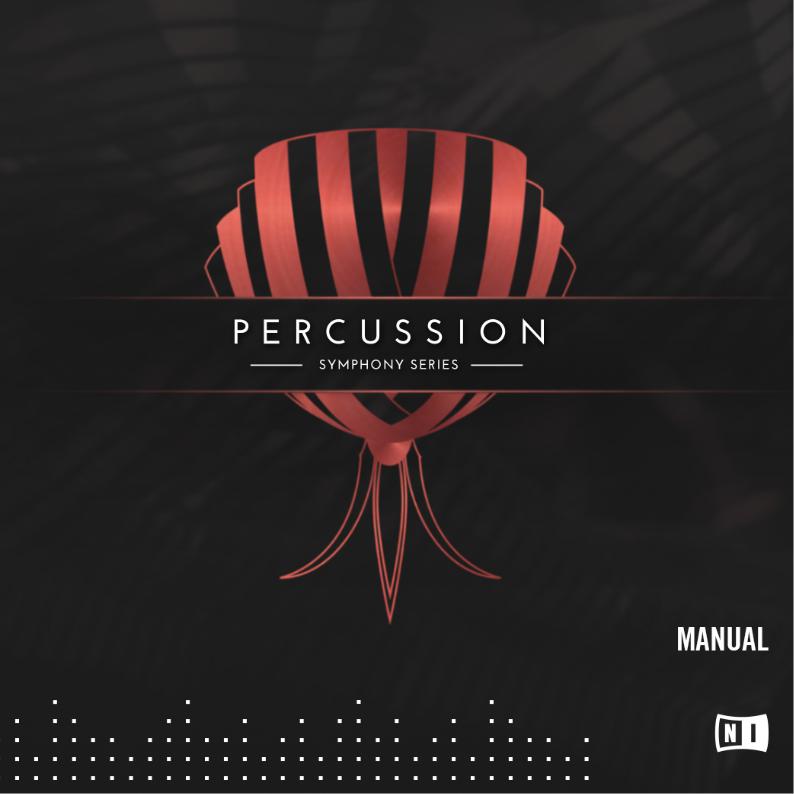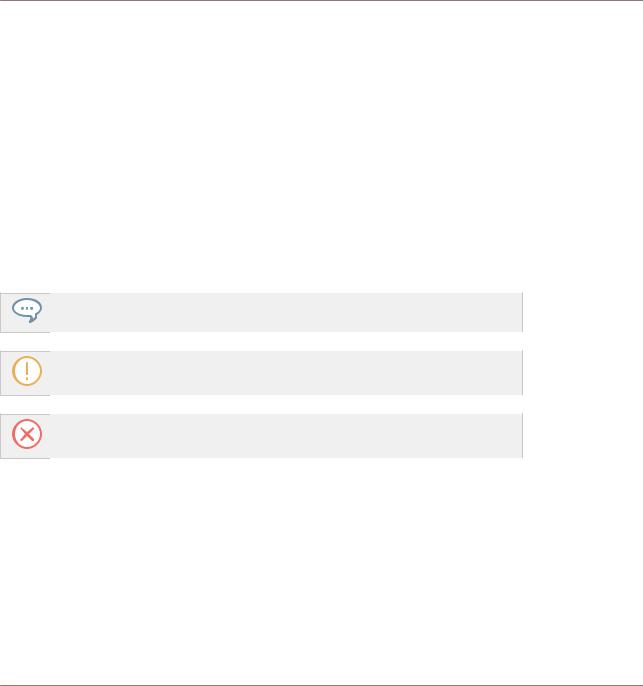Native Instruments Percussion Instruction Manual


Disclaimer
The information in this document is subject to change without notice and does not represent a commitment on the part of Native Instruments GmbH. The software described by this document is subject to a License Agreement and may not be copied to other media. No part of this publication may be copied, reproduced or otherwise transmitted or recorded, for any purpose, without prior written permission by Native Instruments GmbH, hereinafter referred to as Native Instruments.
“Native Instruments”, “NI” and associated logos are (registered) trademarks of Native Instruments GmbH.
All product and company names are trademarks™ or registered® trademarks of their respective holders. Use of them does not imply any affiliation with or endorsement by them.
All specifications are subject to change without notice.
Document authored by: Adam Hanley
Software version: 1.0 (07/2017)
Special thanks to the Beta Test Team, who were invaluable not just in tracking down bugs, but in making this a better product.

Contact
NATIVE INSTRUMENTS GmbH
Schlesische Str. 29-30
D-10997 Berlin
Germany
www.native-instruments.de
NATIVE INSTRUMENTS North America, Inc.
6725 Sunset Boulevard 5th Floor
Los Angeles, CA 90028 USA www.native-instruments.com
NATIVE INSTRUMENTS K.K.
YO Building 3F
Jingumae 6-7-15, Shibuya-ku,
Tokyo 150-0001
Japan
www.native-instruments.co.jp
NATIVE INSTRUMENTS UK Limited
18 Phipp Street London EC2A 4NU UK
www.native-instruments.co.uk
© NATIVE INSTRUMENTS GmbH, 2017. All rights reserved.

Table of Contents
Table of Contents
1 Welcome to the SYMPHONY SERIES ........................................................................... |
6 |
|||
|
1.1 |
Document Conventions ............................................................................................................... |
6 |
|
|
1.2 |
About the SYMPHONY SERIES of Products .................................................................................. |
7 |
|
2 Choosing the Right KONTAKT Instrument ..................................................................... |
8 |
|||
3 Playing SYMPHONY SERIES Instruments ..................................................................... |
9 |
|||
|
3.1 |
Performance Controls ................................................................................................................. |
9 |
|
|
|
3.1.1 |
Dynamics ................................................................................................................... |
9 |
|
|
3.1.2 |
Attack ........................................................................................................................ |
10 |
|
|
3.1.3 |
Release ...................................................................................................................... |
10 |
|
|
3.1.4 |
Tuning ....................................................................................................................... |
10 |
|
|
3.1.5 |
Velocity ...................................................................................................................... |
10 |
|
3.2 |
Mapping ..................................................................................................................................... |
|
10 |
|
3.3 |
Round Robins ............................................................................................................................. |
11 |
|
|
3.4 |
Articulations and Variations ....................................................................................................... |
13 |
|
4 |
KONTAKT Snapshots .................................................................................................. |
15 |
||
|
4.1 |
Saving a User Snapshot ............................................................................................................. |
15 |
|
|
4.2 |
Loading a Snapshot from the Snapshot Menu ............................................................................ |
17 |
|
|
4.3 |
Loading Snapshots from the File System .................................................................................... |
18 |
|
|
4.4 |
Deleting a User Snapshot ........................................................................................................... |
19 |
|
5 |
Audio Mix-down |
........................................................................................................ |
21 |
|
|
5.1 |
The Microphone Mixer View ......................................................................................................... |
21 |
|
|
5.2 |
Refining the Master Mix .............................................................................................................. |
23 |
|
|
|
5.2.1 |
Applying EQ ............................................................................................................... |
23 |
|
|
5.2.2 |
Applying Reverb ......................................................................................................... |
24 |
|
|
5.2.3 |
Applying Comp & Filter .............................................................................................. |
27 |
SYMPHONIC SERIES PERCUSSION - Manual - 4

|
|
|
Table of Contents |
|
|
|
|
|
5.3 |
Balancing Section Volumes ........................................................................................................ |
28 |
|
5.4 |
Transferring Mixer Settings Between Different Instruments ....................................................... |
29 |
6 |
Credits |
...................................................................................................................... |
31 |
SYMPHONIC SERIES PERCUSSION - Manual - 5

Welcome to the SYMPHONY SERIES
Document Conventions
1Welcome to the SYMPHONY SERIES
Thank you for purchasing SYMPHONY SERIES PERCUSSION. This document will give you information about the library, as well as step-by-step instructions and advice on how to achieve the best results with it.
We hope that you will enjoy using the SYMPHONY SERIES products.
1.1Document Conventions
This document uses particular formatting to point out special facts and to warn you of potential issues. The icons introducing the following notes let you see what kind of information can be expected:
The speech bubble icon indicates a useful tip that may often help you to solve a task more efficiently.
The exclamation mark icon highlights important information that is essential for the given context.
The red cross icon warns you of serious issues and potential risks that require your full attention.
Furthermore, the following formatting is used:
▪Text appearing in (drop-down) menus (such as Open…, Save as… etc.) in the software and paths to locations on your hard disk or other storage devices is printed in italics.
▪Text appearing elsewhere (labels of buttons, controls, text next to checkboxes etc.) in the software is printed in blue. Whenever you see this formatting applied, you will find the same text appearing somewhere on the screen.
▪Important names and concepts are printed in bold.
SYMPHONIC SERIES PERCUSSION - Manual - 6

Welcome to the SYMPHONY SERIES
About the SYMPHONY SERIES of Products
▪References to keys on your computer’s keyboard you’ll find put in square brackets (e.g., “Press [Shift] + [Enter]”).
►Single instructions are introduced by this play button type arrow.
→Results of actions are introduced by this smaller arrow.
Naming Convention
Throughout this document, we will refer to SYMPHONY SERIES PERCUSSION as just PERCUSSION.
1.2About the SYMPHONY SERIES of Products
SYMPHONY SERIES PERCUSSION is part of the SYMPHONY SERIES of KONTAKT Instruments. This series supplies composers with a comprehensive tool set for creating highly realistic orchestral productions with an expansive sound full of character.
PERCUSSION allows you to use a production-ready STEREO mix or create your own mix from CLOSE, MID, FAR and SPOT microphone positions. On the dedicated Mixer page, a parametric EQ, convolution REVERB, COMPRESSION and FILTER effects let you adjust the sound to suit any project you're working on.
Five performance controls are pre-assigned to MASCHINE controllers and the KOMPLETE KONTROL S-series of keyboards.
SYMPHONIC SERIES PERCUSSION - Manual - 7

Choosing the Right KONTAKT Instrument
2Choosing the Right KONTAKT Instrument
PERCUSSION ships with a total of 66 KONTAKT Instruments (.nki files). To help you select the right one for your specific task, here is an overview of the included Instruments.
Single Instruments
Single Instruments are KONTAKT Instruments that only contain articulations from a single percussion instrument.
Single Instruments can be found in the following folders:
▪Cymbals: a collection of cymbals and gongs
▪Drums: percussion instruments with membranes, like Bass Drums, Snares, and Toms
▪Metal: metallic percussion that are not part of the Cymbals selection, for example: Triangles and Bells
▪Wood: percussion for which wood is the main sound source, for example: Castanets and Guiro
Tuned Percussion
Like the Single Instruments, the Tuned Percussion contain only one percussion instrument in an nki. However, these instruments are tonal and can be played chromatically.
Examples include: Glockenspiel and Marimba.
Kits
Kits contain a number of different percussion instruments in one nki. In some cases, these are an easier way of getting all of the percussion you need into your track, but with less flexibility in the mix options.
SYMPHONIC SERIES PERCUSSION - Manual - 8

Playing SYMPHONY SERIES Instruments
Performance Controls
3Playing SYMPHONY SERIES Instruments
3.1Performance Controls
When you load a PERCUSSION Instrument, the Performance Controls are the most prominent feature of the Instrument's user interface. These controls are used to refine the response and sound.
The Performance Controls
3.1.1Dynamics
The Dynamics control is assigned to the Mod Wheel (MIDI CC 1) by default. It allows you to control the loudness and intensity of the Tremolo articulations (rolls) in real-time. That way, you can easily automate intensity changes to e.g. transition from leading to supporting passages.
If the Dynamics control is not available, because there are no Tremolo articulations in the loaded Instrument, it is still present and displays an intensity meter for the incoming MIDI notes.
SYMPHONIC SERIES PERCUSSION - Manual - 9

Playing SYMPHONY SERIES Instruments
Performance Controls
3.1.2Attack
The Attack control allows you to increase the fade-in time per note, which can change the hardness of the initial transient. By setting the Attack time to higher values, you can cause the notes to fade in slightly, giving the notes a soft and gentle character.
3.1.3Release
The Release control applies an additional envelope to the fade-out phase of the notes.
Reducing the Release setting to 0% shortens the naturally recorded reverb tails to a minimum, producing a very “dry” sounding result, which can sometimes make the result sound artificial. However, this can be very useful when adding internal or external reverb effects, as this allows the additional reverb to avoid conflicting with the natural sampled ambience.
3.1.4Tuning
The Tuning control sets the overall pitch of the instrument(s).
Even if the instrument is not tuned percussion, matching the tone of a drum to the key of your track can help fit it into your mix.
3.1.5Velocity
The Velocity slider controls the dynamic range of the MIDI notes.
The dynamic range is unaffected when the slider is in the central position. Turing the slider down will make the incoming notes softer and turning it up will make them louder.
3.2Mapping
All of the Single Instruments have a Mapping page which displays the articulation mapping for the Instrument.
SYMPHONIC SERIES PERCUSSION - Manual - 10
